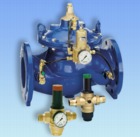Putting pressure on wasted water

Despite a seemingly wet climate, many parts of the UK regularly experience water shortages. The increasing number of homes is expected to exacerbate the problem, especially in the south east of England.
According to Waterwise, the UK’s leading authority on water efficiency, about a third of the water each person uses daily is wasted. It says the key to water efficiency is reducing waste, not restricting use. An independent, not-for-profit organisation, Waterwise is focused on reducing UK water consumption by 2010 and building the evidence base for large-scale water efficiency.
The building-services industry can play a great part in cutting wastage in all types of buildings — including homes, hotels, schools, offices, factories and public buildings — by installing pressure-regulating valves. These valves maintain a constant, ideal pressure supply throughout premises, irrespective of the supply pressure.
Water wastage
The mains water pressure to many premises is much higher than necessary. This contributes to water wastage, as more water flows to waste while taps are running to wash hands, rinse items and brush teeth, for example. A pressure-regulating valve (PRV) on the supply provides a simple, efficient and cost-effective means to reduce water pressure within the system — so reducing consumption.
A lower water pressure also minimises flow noise and protects installations from damage caused by excessive pressure. Connections on hoses to appliances are less likely to leak. Users are also unlikely to be splashed by excessive flow caused by pressure in taps on hand basins.
Waterwise Marque
Among the Waterwise initiatives towards water efficiencies is the Waterwise Marque, awarded to products judged to reduce wastage. Waterwise has recognised the valuable contribution pressure regulation can make to water efficiency by awarding the Marque to the D04FS, D05F and D06F models of PRV from Honeywell.

Small brass-bodied valves such as these are ideal in low-flow situations, even when there are wide inlet pressure fluctuations, up to 25 bar supply pressure. This includes supplies to building sub-units, individual apartments in residential blocks and different levels of tall buildings. The installer sets the output pressure using an adjustment screw. Many such valves have a calibrated adjustment knob with a set point scale; this means there is no need for a gauge, although a gauge port is provided if required. Many PRVs have an integral fine filter to protect the valve insert. These filters are usually fully serviceable, and Honeywell valves have a simple cartridge system to make this easy, without losing the setting on the valve.
Large buildings and campuses
Large flanged, cast-iron valves are required to regulate pressures in high-flow applications, such as main supplies to industrial and commercial premises, hospitals, campuses and multi-dwelling buildings. Smaller brass-bodied PRVs can then be installed additionally to control flows to individual floors, apartments and sub-units.
The water system in a tall building is rarely supplied directly from the mains, but usually fed at a high pressure by a booster set. This ensures delivery to the top floor at adequate pressure — say, 2 bar. However, without pressure regulation, the pressure would be increasingly greater on lower floors. Excessive pressures at lower levels are likely to result in water wastage for the reasons described above. A PRV should therefore be fitted in the supply to each level to ensure the constant ideal pressure.
Where large reductions in water pressure are to be made, it is good practice not to reduce pressure by more than 5:1 in a single step. To reduce 18 bar to 1.5 bar for example, two valves in series are recommended, allowing a good gap between them. The first PRV could reduce pressure to 6 bar and the second to 1.5 bar.
Martin Strom is business manager with Honeywell Water Products.








